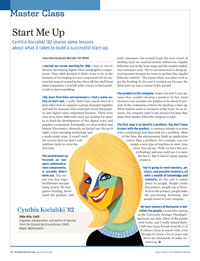Master Class
 (Illustration: David Cowles for Rochester Review)
(Illustration: David Cowles for Rochester Review)I started my career working for IBM. I was in the PC division developing digital video and graphics components. Then IBM decided it didn’t want to be in the business of developing its own components for its systems but instead wanted to buy them off-the-shelf from other companies. I was left with a choice to find another job or start something.
Like most first-time entrepreneurs, I had a naïve notion of start-ups. I really didn’t have much more of a plan other than to organize a group of people together and look for someone who would put us into the graphics and digital video component business. There were nine of us from IBM who went out looking for money to fund the development of this digital video and graphics component. Eventually, we were folded into Matrox Electronics. Honestly, we lucked out. We got it right—a hot emerging technology and a ready-made team. It wasn’t until the second start-up that I realized how lucky we were the first time.
The second start-up focused on network communications components. It actually didn’t work out. The reason was that Gigabit Ethernet was just being touted. We had gotten funding, developed the product, had early customers, but waited to get the next round of funding until we reached certain milestones. Gigabit Ethernet was in the hype stage and the market stalled. Our customers said, “We’re not interested in doing optical anymore because we want to see how this Gigabit Ethernet unfolds.” The lesson there was don’t wait to get the funding. In the end it worked out because the third start-up was a variant of the second.
The product is the company. Start-ups don’t fail because they couldn’t develop a product. In fact, most investors only consider the product to be about 10 percent of the evaluation criteria for funding a start-up. What matters most to investors is the team. To an investor, the company itself is the product because they make their money when the company is sold.
Cynthia Kocialski ’82
Palo Alto, Calif.
Engineer, entrepreneur, and author of Startup from the Ground Up (CreateSpace, 2010)
Major: Mathematics
The first step is to identify a problem. You don’t have to start with the product. A common mistake is to start with a technology and then look for a problem. Most of the time, the entrepreneur finds an application rather than a problem. For example, you can design a new type of machine to mow your lawn. You can say, “Well, we have this new technology, and you could use it to mow the lawn.” But it doesn’t mean anyone wants it.
You’re going to need mentors, advisors, and possible investors, all with a wealth of knowledge and contacts. In the end it comes down to people. People create the product, people use or benefit from the product, people make the purchasing decisions, and people invest in your company.
My best memory of Rochester is definitely the people. I remember staying at the University through Thanksgiving break one time. Most of the people went home, and I really missed them. I still have many friends from the U of R whom I keep in touch with, even though it’s been a lot of years and there are thousands of miles between us.

